Search results for: 'For'
-
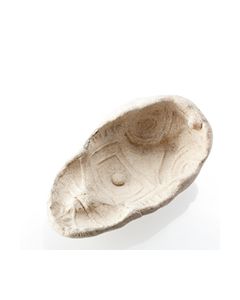 Maya-Kultur - Gussform für Fabelwesen
Maya-Kultur - Gussform für FabelwesenDie Form ergibt ein stilisiertes Tier oder ein Fabelwesen. Rückseite flach. Etwa 300 n. Chr. bis 900 n. Chr.
Price: on request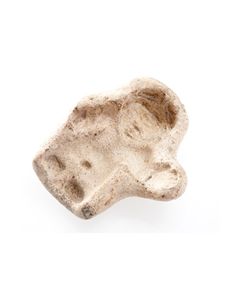 Maya-Kultur - Gussform für männliche Figur
Maya-Kultur - Gussform für männliche FigurForm ergibt eine gedrungene männliche Figur mit erhobener Hand und angedeutetem Phallus. Deutliche Gesichtszüge und Kopfbedeckung.
Price: on request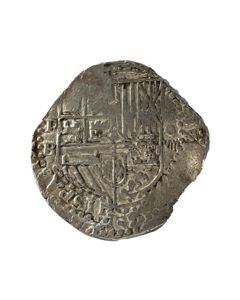 8 Reales, also known as cob coin, piece of eight or pirate money
8 Reales, also known as cob coin, piece of eight or pirate moneyPotosi, Bolivia. Very fine, rare quality and preservation for a cob coin.
Price: on request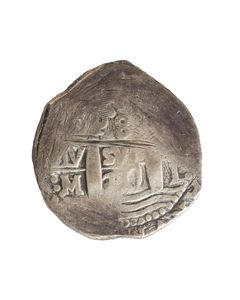 Rare 8 Reales cob coin
Rare 8 Reales cob coinLima, struck 1717 under Philipp V. Very fine, nice quality and preservation for a cob coin. Also known as piece of eight or pirate money.
Price: on request 8 Reales, also known as cob coin, piece of eight or pirate money
8 Reales, also known as cob coin, piece of eight or pirate moneyPotosi, Bolivia. Very fine, nice quality and preservation for a cob coin. This type of coins is also known as pieces of eight or pirate money
Price: on request 8 Reales, also known as cob coin, piece of eight or pirate money
8 Reales, also known as cob coin, piece of eight or pirate moneyPotosi, Bolivia. Very fine, nice quality and preservation for a cob coin.
Price: on request Gourd shaped bowl of the Chimú culture
Gourd shaped bowl of the Chimú cultureElegant bowl with shiny black surface. Precolumbian pottery of the 10th to 15th century.
Price: on request Jaguar vessel of the Guanacaste-Nicoya peoples
Jaguar vessel of the Guanacaste-Nicoya peoplesThe imposing vessel shows not just a jaguar but a transformed shaman in his animal form. It was made in Pre-Columbian Mesoamerica between 800 and 1200 AD and used for funeral purposes in the Guanacaste region.
Price: on request Jama-Coaque roller stamp
Jama-Coaque roller stampClay roller stamp with rich ornamental relief to apply skin decoration. This tool was used in the early phase of the ecuadorian Jama-Coaque culture.
Price: on request Mochica stirrup vessel as a shaman
Mochica stirrup vessel as a shamanImposing Peruvian vessel shaped like a priest on a podest with rich adornments. Circa 100 to 500 AD. With documents form the 1980ies.
Price: on request Large ceremonial knife of the Sican culture
Large ceremonial knife of the Sican cultureThe so-called Tumi was a weapon to cut the throats of humans and animals in ritual sacrifices. The knife certainly fulfilled an additional representative function in the afterlife. From the period of the Sican's cultural florescence during the 10th to 12th centuries AD.
Price: on request Ceremonial knife of the Sican culture
Ceremonial knife of the Sican cultureThe so-called Tumi was a weapon to cut the throats of humans and animals in ritual sacrifices. The knife certainly fulfilled an additional representative function in the afterlife. From the period of the Sican's cultural florescence during the 10th to 12th centuries AD.
Price: on request Small ceremonial knife of the Sican culture
Small ceremonial knife of the Sican cultureThe so-called Tumi was a weapon to cut the throats of humans and animals in ritual sacrifices. The knife certainly fulfilled an additional representative function in the afterlife. From the period of the Sican's cultural florescence during the 10th to 12th centuries AD.
Price: on request Ceremonial knife of the Sican culture
Ceremonial knife of the Sican cultureThe so-called Tumi was a weapon to cut the throats of humans and animals in ritual sacrifices. The Tumi certainly fulfilled an additional representative function in the afterlife. From the period of the Sican's cultural florescence during the 10th to 12th centuries AD.
Price: on request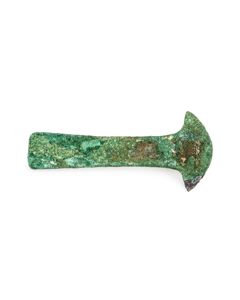 Ceremonial knife of the Sican culture
Ceremonial knife of the Sican cultureThe so-called Tumi was a weapon to cut the throats of humans and animals in ritual sacrifices. The knife certainly fulfilled an additional representative function in the afterlife. From the period of the Sican's cultural florescence during the 10th to 12th centuries AD.
Price: on request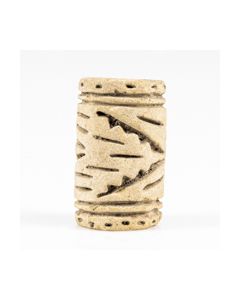 Jama-Coaque roller stamp
Jama-Coaque roller stampClay roller stamp with relief of stylized plants used to apply skin decoration. This tool is from the early phase of the ecuadorian Jama-Coaque culture.
Price: on request Jama-Coaque roller stamp
Jama-Coaque roller stampClay roller stamp with relief of plants to be applied as skin decoration. This tool was used in the early phase of the ecuadorian Jama-Coaque culture.
Price: on request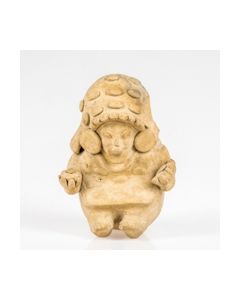 Sculpture of a Jama-Coaque chieftain
Sculpture of a Jama-Coaque chieftainThe clay figure from the earliest phase of the Jama-Coaque culture shows the preparation of coca leaves. Including TL test from Kotalla laboratory.
Price: on request Exceptionally well minted 8 Reales coin
Exceptionally well minted 8 Reales coinPotosi, Bolivia, ca. 1st half 17th century AD. This type of coins is also known as cob coins, pieces of eight or pirate money
Price: on request Stirrup vessel with lizzards
Stirrup vessel with lizzardsBeautiful vessel from the golden age of the Moche culture. It shows two lizzards on each side. 100 to 500 AD.
Price: on request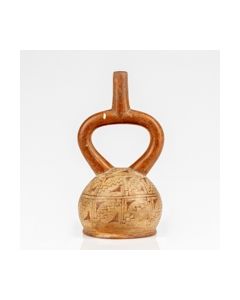 Mochican stirrup vessel with museum provenance
Mochican stirrup vessel with museum provenanceElegant vessel of the late Moche culture. Wonderful geometrical decoration in near perfect condition.
Price: on request Jama-Coaque roller stamp
Jama-Coaque roller stampClay roller stamp with relief of mythological creatures to be applied as a skin decoration. This tool was used in the early phase of the ecuadorian Jama-Coaque culture and was found in Pedernales.
Price: on request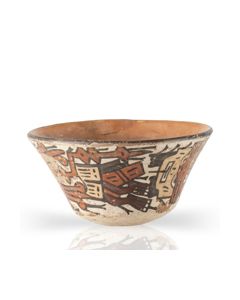 Bowl of the Nazca culture
Bowl of the Nazca cultureWith polychrome abstract depiction of people and masks, possibly a deity. Nice vessel from the Nazca Golden Age.
Price: on request Stirrup vessel of a shaman
Stirrup vessel of a shamanBeautiful vessel from the golden age of the Moche culture. It shows a blind Shaman with a rattle in his hand. 200 to 400 AD, including TL analysis.
Price: on request Bowl of the Chancay culture
Bowl of the Chancay cultureFlat pottery bowl with abstract painting. The pre-Columbian art of the Chancay seems simple at first, but radiates an elegance that still seems modern today.
Price: on request Bowl of the Chancay culture
Bowl of the Chancay cultureThin-walled pottery bowl with abstract painting. The pre-Columbian art of the Chancay seems simple at first, but radiates an elegance that still seems modern today.
Price: on request Bowl of the Chancay culture
Bowl of the Chancay cultureFlat pottery bowl with abstract painting. The pre-Columbian art of the Chancay seems simple at first, but radiates an elegance that still seems modern today.
Price: on request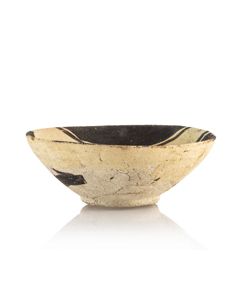 Bowl of the Chancay culture
Bowl of the Chancay cultureFlat pottery bowl with abstract painting on the inside. The pre-Columbian art of the Chancay seems simple at first, but radiates an elegance that still seems modern today.
Price: on request Bowl of the Chancay culture
Bowl of the Chancay cultureThin-walled pottery bowl with abstract painting. The pre-Columbian art of the Chancay seems simple at first, but radiates an elegance that still seems modern today.
Price: on request Bowl of the Chancay culture
Bowl of the Chancay cultureThin-walled pottery bowl with abstract painting and plastic animal head handles. The pre-Columbian art of the Chancay seems simple at first, but radiates an elegance that still seems modern today.
Price: on request Beaker of the Nazca culture
Beaker of the Nazca cultureVessel made by the precolumbian Nazca culture and painted in bright colours. From the early phase between the 1st and 5th century
Price: on request

